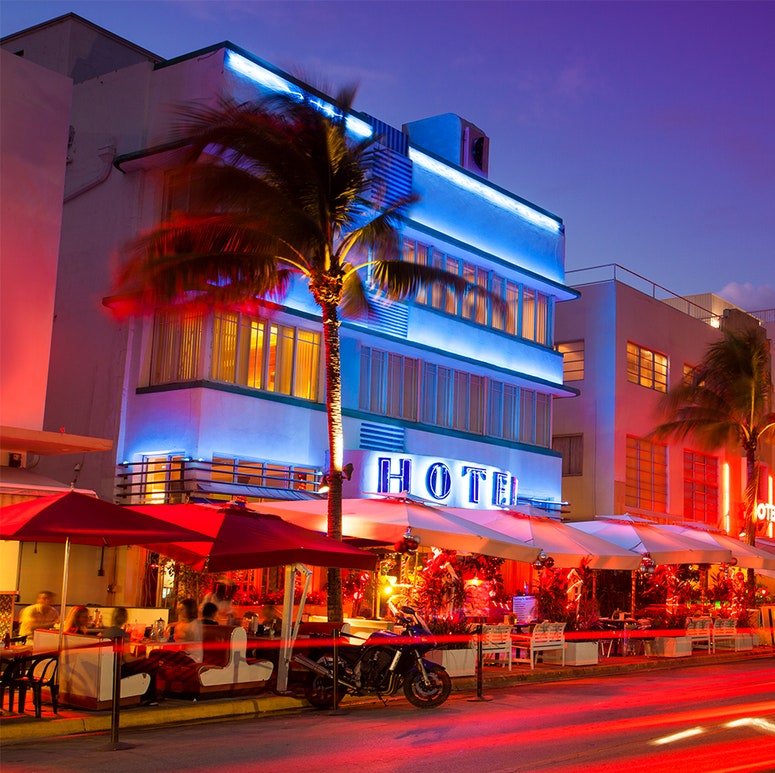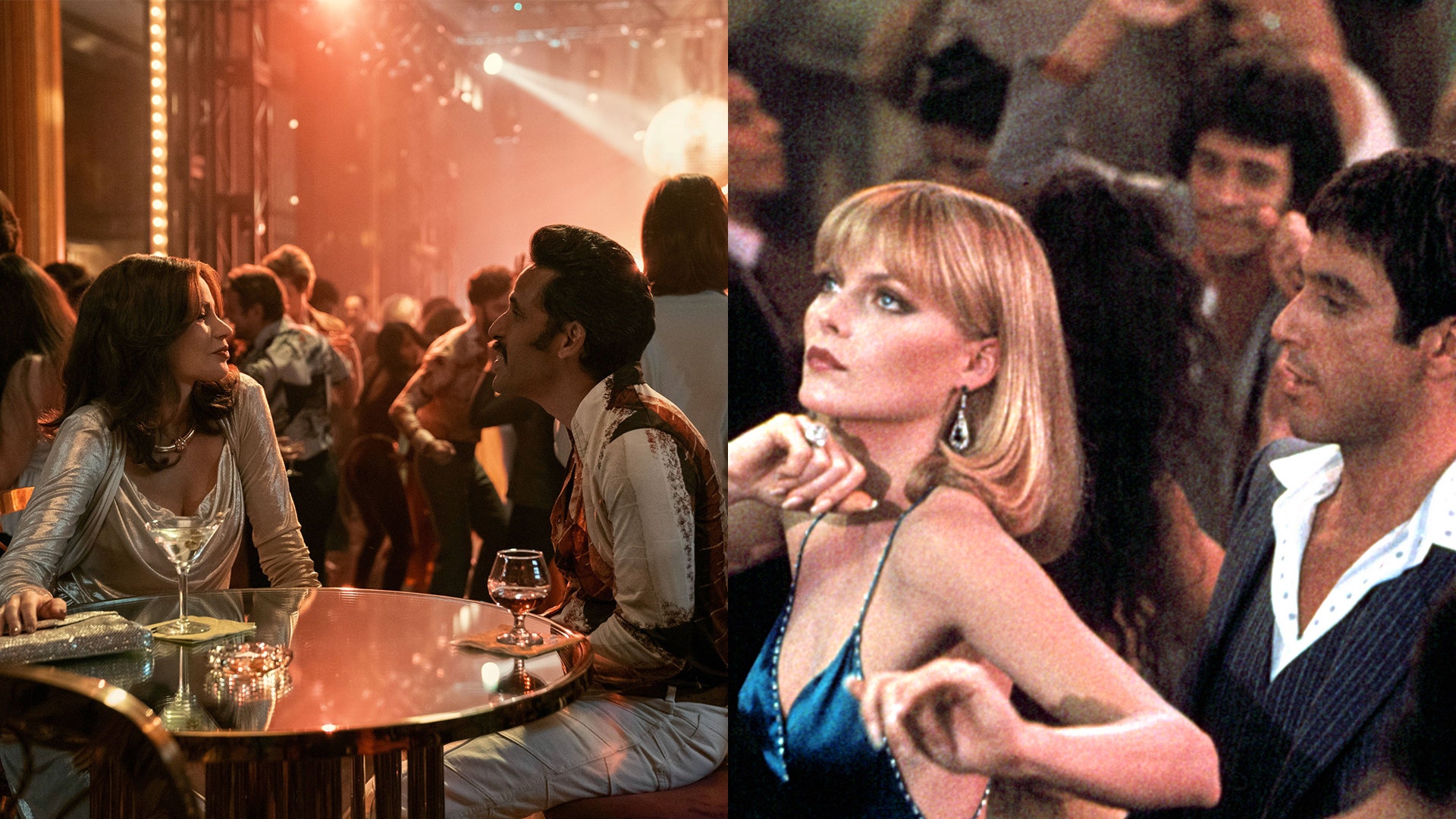All products are independently selected by our editors. If you buy something, we may earn an affiliate commission.
Type “The Mutiny Hotel” into Google Maps and you’ll swiftly find yourself on a sun-drenched main road in Miami, Florida. Palm trees dot the sidewalk. The sky resembles a huge, blue dome. And to your left, shrouded behind a constellation of shrubs, you’ll spot a salmon-pink tower block with a small green sign. It’s innocuous enough – it could be any other Miami hotel; the sort of place families go to lounge by the pool as couples sip cocktails at the marble bar. But rewind a few decades, to the late ‘70s and early ‘80s, and the Mutiny nightclub – a private club inside the 130-room hotel – was known best as a notorious hangout for musicians, CIA affiliates and, of course, Miami’s drug kingpins.
If you’ve watched Griselda – the Narcos spin-off currently on Netflix, you’ll already be familiar with the Mutiny. It’s where Griselda Blanco, based on a real-life kingpin and played by Sofia Vergado, strikes up the majority of her deals, usually surrounded by wheeler-dealer guys in low-buttoned shirts and flares as Boney M tracks pump across the dancefloor. Such scenes weren’t actually filmed at the Mutiny, as the club no longer exists. Instead, they were recreated inside the ballroom of a retired ocean liner, the Queen Mary, in Long Beach. “We had quite a bit of liberty with Mutiny because it was a secret, members-only club,” says the Griselda set decorator Kim Leonard. “There’s not a lot of evidence to back up what it looked like, so we knew what the feel of it was like – the excess of Miami in that time period – but maximised.”
Griselda isn’t the first time the Mutiny nightclub has been depicted on screen – it was famously the inspiration behind Scarface and their fictional club The Babylon. Scarface came out in 1983, just as the Mutiny was cleaning up its act – but hotel founder Burton Goldburg reportedly wouldn’t allow director Brian De Palma to film on the actual location. Instead, the purple-tinged, mirrored interior of The Babylon was shot inside a Hollywood soundstage, with the club mirrors padded with soft foam and covered in transparent acrylic so that the famous shootout scene could be filmed without too much broken glass or injury. As for the Babylon exterior, that was made from a bunch of props assembled in Florida – it is now just an empty carpark.
But what of the real club itself? What was it actually like to party at the Mutiny? Roben Farzad, author of Hotel Scarface: Where Cocaine Cowboys Partied and Plotted to Control Miami, describes the club as “one of the hedonism capitals of the world. The way you saw celebrities, drug kingpins and CIA-adjacent people and arms dealers throw money around in pornographic terms was unparalleled. They’d throw tens of thousands of dollars down the drain for a Dom Perignon-filled hot tub. That shows you how much money was sloshing around Miami – how little and everything money meant.”
Grand Theft Auto 6 will see Miami become Rockstar Games’ next battleground for would-be kingpins. But what are the clubs, mansions and dive bars that should make the jump from IRL to Vice City?

Farzad tells GQ that De Palma and Scarface writer Oliver Stone stayed at the Mutiny before filming, with cast members Michelle Pfeiffer and Al Pacino leaving flowers for the staff. Steven Bauer, who plays Manny Ribera, was even an actual member. “They definitely wanted to replicate [the Mutiny],” he says. “And certainly the kingpins themselves. Robert Loggia’s character [Frank Lopez] was based on Carlene Quesada [who ruled at the Mutiny]... ultimately, much of this movie was shot in Southern California and, just like with Griselda, they had to make a cheap facsimile of what the Mutiny was. There’s very little true photography, and practically no video footage of the place.”
When it comes to Griselda, Farzad isn't too convinced by the show's realism, describing the club scenes as “Not very dead on. It’s just kind of a generic discoteque.”
“Griselda [Blanco] wasn’t omnipresent at the Mutiny,” he adds. “There’s evidence that she went there to party, she went there to recruit other hitmen, she was hitting on one of the bodyguards. But the Colombians overwhelmingly were not the flashy ones – they were businesslike. The unwritten rule for the Colombian people was to look like they were living the American dream, to not draw attention to [themselves].”
By 1983, the year that Scarface came out, the real-life Mutiny had cleaned up its act. “It sold at the end of 1983 and new management came in and pretty much destroyed it from day one,” says Farzad. “They tried to make it more ‘upscale’ – but by then there were other clubs. This place became a victim of the savings and loans crisis. People stopped showing up in the mid-80s. The club all but shut down in 1987 and the property remained abandoned for a decade.” As for the club as it stands today, it's just a “really sedate, generic family hotel,” says Farzad.
And, if you haven't yet seen enough of the Mutiny, MGM+ have a new crime thriller series in the works. Hotel Cocaine will focus on the general manager of the Mutiny Hotel, Roman Compte, and how he made a life for himself in Miami. Whether they'll film in the actual hotel, or a glitzy, mirrored imitation like Griselda and Scarface before it, remains to be seen.

